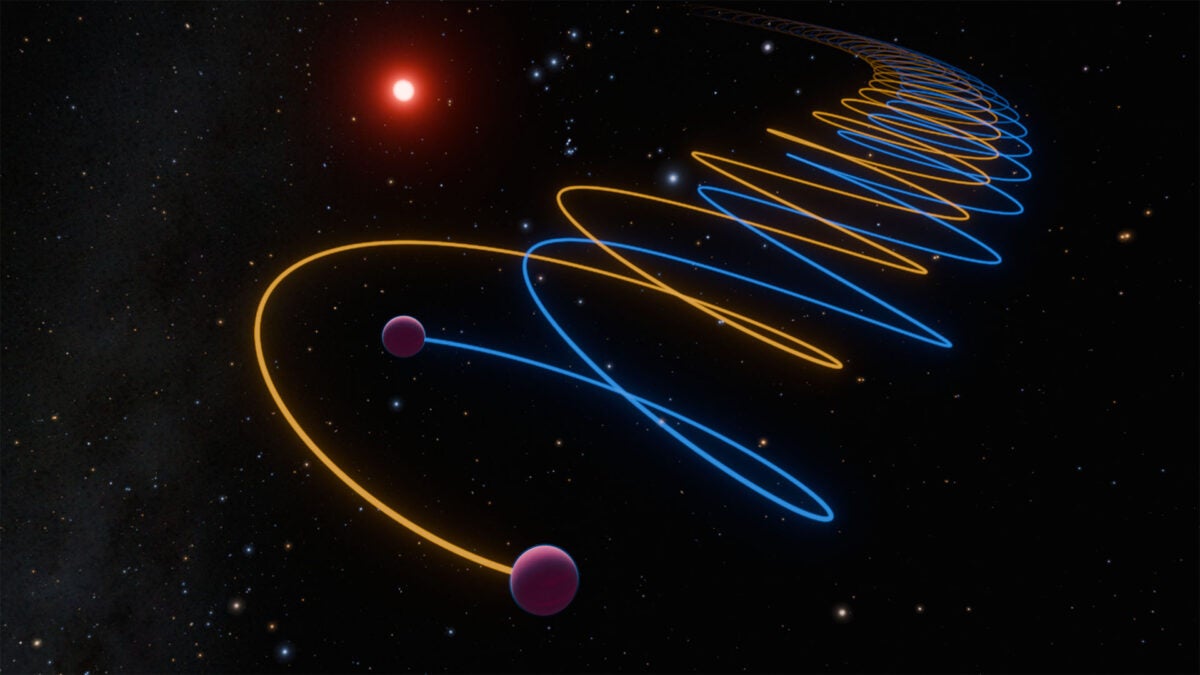Gliese 229 B, discovered in 1995, has long stumped scientists. Now, we know why — it is a binary system of two brown dwarfs orbiting each other, in orbit around their parent red dwarf star.

This artist’s illustration shows the Gliese 229 system, with a red dwarf primary in the background and two brown dwarfs orbiting each other in the foreground. Credit: K. Miller, R. Hurt (Caltech/IPAC)
In 1995, a parallel race was on in astronomy — one to find the first planet beyond our own solar system, and the other to find the first brown dwarf, a class of object too heavy to be a planet, but below the mass of a star.
Astronomers ended up publishing the discovery of the first exoplanet around a Sun-like star — 51 Pegasi b — in early October that year, and the announcement of finding the brown dwarf, Gliese 229 B, at the end of November. Except now, it turns out they didn’t discover the first confirmed brown dwarf.
They discovered two brown dwarfs.
In independent research published in Nature and The Astrophysical Journal Letters, astronomers announced the true nature of Gliese 229 B — and, in the process, solved a lot of mysteries around what’s happening there.
Huddled close together
Brown dwarfs form not unlike stars, except brown dwarfs fail to reach a mass threshold to fuse hydrogen into helium. The cutoff varies depending on composition and other mitigating factors, but usually objects around the mass of 70 to 80 Jupiters have enough of what it takes to become a bona fide star.
That’s right around the estimated mass of Gliese 229 B, which orbits a red dwarf parent star about 60 percent the mass of the Sun. But despite the fact that Gliese 229 B appeared to be itself sitting at the threshold of being a star, it hadn’t ignited, and stayed relatively cold.
“There’s basically this tension between the high mass of this object and the fact that it’s so faint and cold, which didn’t make sense, given our models of brown dwarfs,” Jerry W. Xuan, a Caltech grad student and lead author of the Nature paper, says. “So people have hypothesized that it could be a binary brown dwarf and that could solve this problem.”
Gliese 229 B is only about 19 light-years from Earth. Xuan says this led the team to realize that since they hadn’t detected a binary object after years of searching with both space-based missions and instruments on the ground, the two objects would have to be very close to each other. The team used the GRAVITY interferometer, which can closely watch changes in the path of an object caused by unseen objects, and the CRIRES+ spectrograph, which breaks down an object’s light to identify its constituent molecules.
While Gliese 229 B isn’t bright enough to shine as a star, it’s still warm from its formation and relatively young age, so the object can be directly imaged. (Hubble did so to help confirm its detection in 1995.) This also means that it could be closely studied to determine whether it’s wobbling due to an unseen companion, as well as gather details about both objects if so.
And that was exactly the case: Gliese 229 B is composed of a 38-Jupiter-mass brown dwarf in a mutual orbit with a 34-Jupiter-mass brown dwarf, orbiting each other just 4 million miles (6.4 million kilometers) apart. That’s a very small distance, cosmically speaking. (For reference, the Sun is an average of 93 million miles [150,000 km] from Earth, and the Moon is an average of 238,000 miles [383,000 km] from Earth.)
Origin story
Xuan says the brown dwarfs likely formed from instabilities in the same disk of material that formed their parent star, Gliese 229 A, and thus formed somewhat like stars, themselves. But for some reason, each of the brown dwarfs formed distinct from one another rather than as one small protostar. It may be that the ignition of Gliese 229 A prevented the objects from forming as one.
“The disk would need to be massive enough to contain enough mass for the two brown dwarfs, but if it did, then such a massive disk would likely be unstable to gravitational collapse, and that would mean that you basically fragment into these smaller objects around the star,” Xuan says.
Xuan and colleagues have observing time coming up on the James Webb Space Telescope, which will help them learn more about the brown dwarf pair, including measuring their radii directly. The details they glean could help us learn more about what are now the first two confirmed brown dwarfs and give insight into how these enigmatic objects form.
And it could open up an even more wild possibility within a system that already has one star, two brown dwarfs, and evidence for a couple Neptune-sized planets in it.
“So I would say that it’s not a priority … and this is more hypothetical, but if we collect a lot of data on the orbit of the brown dwarf binary, we could see if there’s any evidence that there’s something else around them,” Xuan says. In other words, Xuan’s team might be able to find out whether two brown dwarfs orbiting each other, both in orbit around a larger star, might have a small planet orbiting them, as well.
It would certainly make for an interesting find.

